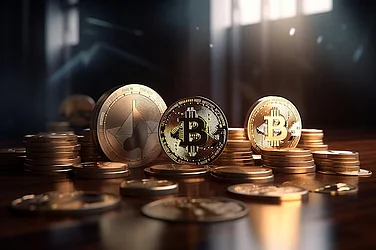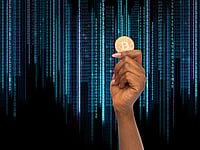A Non-Fungible Token (NFT) is a unique digital certificate of ownership that is stored on a blockchain. Think of it like a digital deed or an official, tamper-proof receipt for a specific item, whether it's a piece of digital art, a song, or an in-game asset.
Unlike cryptocurrencies like Bitcoin, where every coin is identical (fungible), each NFT is one-of-a-kind (non-fungible). This uniqueness is what allows them to represent ownership of a specific digital or physical item.
Learn More: The NFT Horizon: Future Trends Shaping the Digital Asset World
Understanding the Technology Behind NFTs
Now that you know the basics, let's look a little closer at the technology that makes NFTs possible.
Fungible vs. Non-Fungible: The Key Difference
The "Non-Fungible" part of NFT is the most important concept.
Fungible items are interchangeable. A $10 bill is fungible because you can trade it for any other $10 bill. They have the same value and are not unique. Cryptocurrencies like Bitcoin are fungible.
Non-Fungible items are unique and cannot be replaced with another. The original Mona Lisa painting is non-fungible. An NFT is the same—it's a one-of-a-kind digital token.
A digital artwork or a limited-edition collectible, when turned into an NFT, has unique properties that make it distinct from any other token.
A Crucial Distinction: The NFT is the Receipt, Not the Art
This is a common point of confusion. The NFT itself is not the image or the video file. Instead, the NFT is a proof of ownership recorded on the blockchain.
Think of it like a digital receipt or a deed to a house. The deed proves you own the house, but it isn't the house itself. The NFT is a token on the blockchain that points to where the actual file is stored (often on a decentralized network) and provides an unbreakable, public record of who owns it and its entire sales history.
Powered by Blockchains
This entire system of verifiable ownership is made possible by blockchains. The most popular blockchain for NFTs is Ethereum, but others like Solana and Polygon are also widely used. These networks provide the security and transparency that allow NFTs to be minted, bought, and sold in a decentralized way.
How Do NFTs Work?
NFTs work by using blockchain technology to create a permanent, public record of ownership.
Creation (Minting): An artist or creator "mints" an NFT, which creates a unique token on a blockchain like Ethereum. This token contains information about the item, such as its creator and a link to the digital file.
Ownership: When you buy an NFT, the blockchain is updated to show that your crypto wallet address now owns that specific token. This record is permanent and cannot be altered.
Transfer: You can sell or gift the NFT, and each new transaction is added to the blockchain's history, creating a verifiable chain of ownership (provenance).
What Gives an NFT Its Value?
The value of an NFT is determined by supply and demand, based on a few key factors:
Scarcity: The creator can decide to mint only one unique NFT or a limited series, creating digital scarcity.
Authenticity & Provenance: The blockchain provides a fraud-proof history of who created it and who has owned it.
Utility: Some NFTs act as a key, granting access to exclusive online communities, live events, or special features in a video game.
Cultural Relevance: An NFT can become valuable if it's tied to a famous artist, brand, or a significant cultural moment.
Use Cases: What Can NFTs Be Used For
NFTs are extremely versatile and can be utilised to represent any asset type. Some of the predominant use cases are:
Digital Art
Music and Entertainment
Gaming Assets
Virtual Real Estate
Collectibles and Avatars
Fashion and Wearables
Certification and Identity
NFT Royalties: New Economic Model
One of the most forward-thinking aspects of NFTs is programmable royalties with smart contracts. They allow creators to automatically collect a percentage of profit whenever their NFT is being resold. The royalty percentages are usually 5% to 15%, set at mint.
This strategy is contrary to conventional creative economies in which artists receive payback only once from original sales. In NFTs, creators receive long-term appreciation for their art and occasional earnings.
But other platforms have added on optional royalties, and there is fierce controversy over how to secure creator rights. Developers are experimenting with forced royalty models and fair pay-platforms.
Legal, Ethical, and Environmental Issues
Learn More: A Complete Guide to Legal Compliance and Ethical Responsibility in NFT Platforms
Bold as they are, NFTs do have some real problems as well:
Copyright Muddle: NFT ownership is not automatically copyright.
Plagiarism and Scams: Stealing work from others is a huge problem.
Eco-Friendliness: Early NFTs employed proof-of-work, which was a highly energy-hungry protocol. That's a relief from the past with Ethereum's shift to proof-of-stake.
Market Risks: The market is wildly volatile, rife with scams and pump-and-dump schemes.
Regulatory Uncertainty: Legal status of NFTs uncertain in most jurisdictions.
Cultural and Social Impact
NFTs revolutionized the way human beings build communities and represent digital identity. The majority of NFT owners engage with web communities, attend web gatherings, or use an NFT as a profile picture to demonstrate values, interests, or affiliation. The phenomenon is turning the NFT into social money on the internet.
Conclusion
In essence, Non-Fungible Tokens (NFTs) are best understood as digital certificates of ownership. They use the power of blockchain technology to prove who owns a unique digital item, whether it's art, a collectible, or an in-game asset. By making digital content provably scarce and authentic for the first time, NFTs are a revolutionary technology that is fundamentally changing our ideas about value and ownership in the digital world. While the market is still young and carries risks, the core concept of true digital ownership is here to stay.





















